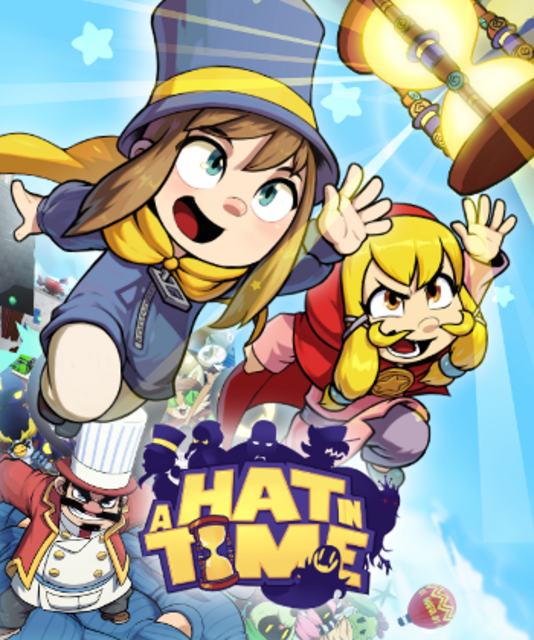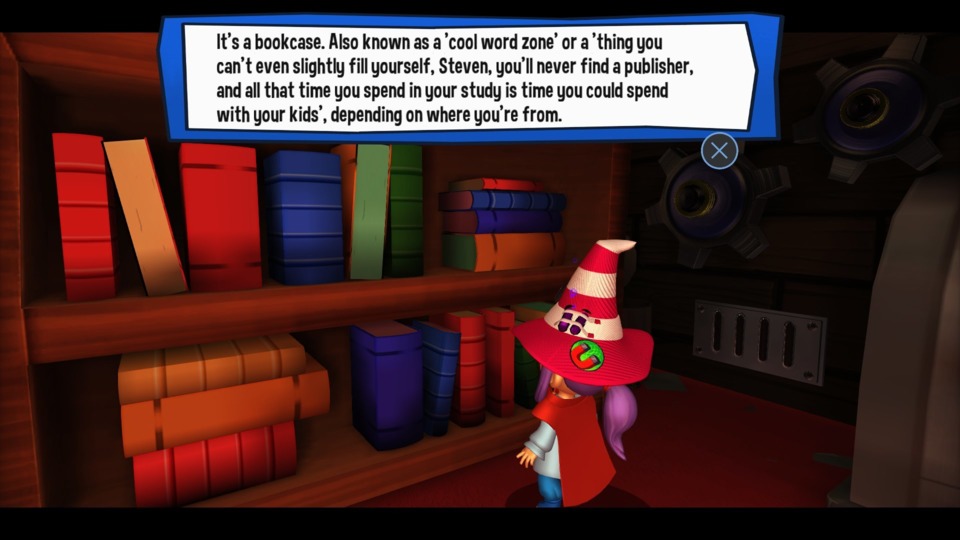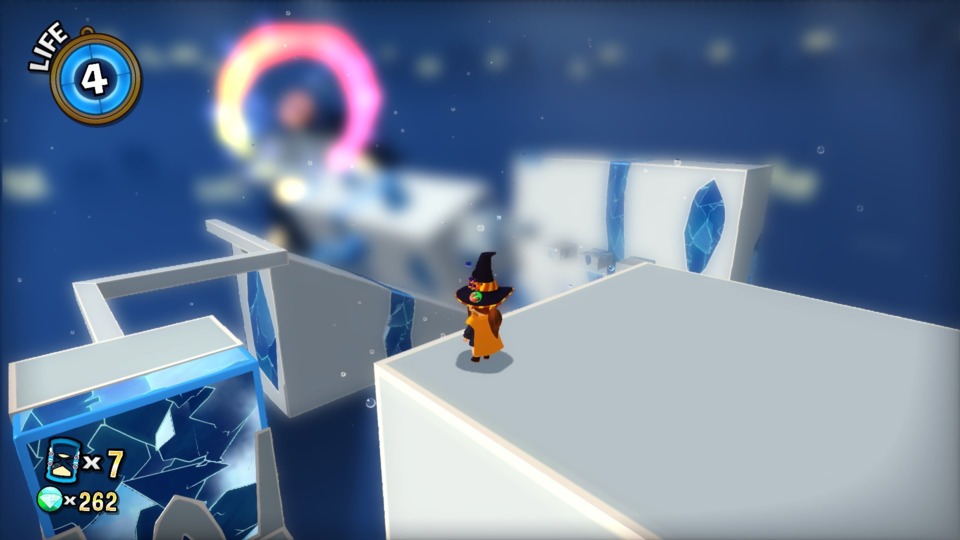Indie Game of the Week 91: A Hat in Time
By Mento 2 Comments

No-one's more stoked for the coming dominance of Indie 3D platformers as I am. A few years ago, a lot of the hopes that the Indie scene would eventually progress from 2D NES and SNES platformers to revisiting the N64 era and the Rare collectathons of the late 90s were pinned on a little game in-development called A Hat in Time, with a small team of creators outlining a strong vision for a bright and colorful and tchotchke-laden 3D platformer but having a little trouble getting the resources together to make it. Like Owlboy, it sort of existed in the PAX periphery for many years popping up every so often in discussions in a "what ever happened to...?" context, eventually looking to crowdsourcing for the revenue it needed to finish production. Of course, by the time it came out last October, it was already part of a wave of Indie collectathons like Skylar & Plux (reviewed here), Yooka-Laylee (reviewed here), Snake Pass (reviewed here), and Poi (coming soon!).
What I will commend A Hat in Time for first and foremost is its boundless imagination. It has forty story collectibles scattered across four "worlds", plus the player character's hub spaceship home, and each of these worlds not only has a distinct setting but follows their own set of rules, which often means completely different gameplay conventions to follow. The first, Mafia Town, eases you into the game with what is essentially an enormous map that contains a number of objectives that lead to collectibles, Super Mario 64 style. The subsequent world, Battle of the Birds, has the player taking part in competing productions to help two factions - owls and penguins - win a prestigious movie award. Success in these challenges are contingent on how effectively you stick to the script, which can range from leading a parade to solving a murder. The third world, where I'm currently playing, involves completing a set of objectives outlined in a Faustian contract that forces you to sign away your soul until you have completed your tasks; to progress in this area, you have to keep signing contracts and solving their stipulations. So far here, I've had to defeat an evil toilet (shades of the Great Mighty Poo), complete a time challenge on a scooter, and traverse a scary mansion with an insta-kill terror skulking around it that you have to hide from. Though there's usually a lot of platforming involved, each mission within each world has felt very different, and I can certainly respect any game that maintains that level of variety.

However, to get all compliment sandwich for a moment, that ambition is also the source of many of the game's figurative pitfalls. As you might expect from a great range of mission types, there's something of a hit and miss nature to the game, especially in those cases where the mission design is writing checks that the controls and interface can't cash. For instance, the game has a few stealth sequences that aren't helped at all by the typically wonky camera of a 3D platformer, the vision cones you need to avoid not always apparent depending on where the camera is facing. Many of the achievements (which, granted, are optional by design) involve "don't die" and "don't get caught" requirements that aren't so easy to pull off when the game's bugs and shortcomings can unexpectedly screw you over in all sorts of ways. Ambition's a fine thing to have when creating a game that's meant to be a progression of an antiquated genre as much as it is a deferential homage - a step forward in the scope of what can be done within that framework - but there are frequent occasions when A Hat In Time will bite off more than it can chew, especially with the unfortunate reality of having limited means behind your production that precludes pulling off everything you envisioned in the way you envisioned it. Then there's graphical problems like how the game can be incredibly dark sometimes, to the extent that I can barely see the ground or where to go next, or a personal bugbear in this genre where the status of certain game geometry (that is, whether or not they can stood upon) is often ambiguous. I feel bad for slapping down the hand that tries to overreach, as we definitely need more Indie developers (especially of platformers and spacewhippers) to come out of their comfort zones and break past the boundaries of the 1990s games they nostalgically imitate, but I feel A Hat in Time could've used a little more fine-tuning in multiple areas.
At the same time, there's a lot about A Hat in Time's presentation and genial, madcap attitude that I appreciate. The game's developers were - fairly, I might add - criticized for leaving in the voicework of one Jon Jafari, another sad case of a YouTuber who got angrier and more racist the more famous they became but was originally a champion of Rare's platformers on his channel and during his tenure on Game Grumps, and while his role is relatively minor and inconsequential and easy enough to ignore, that also applies to how easy it would've been to excise it. The issue, then, was more that the developers doubled down on their decision to keep him in even after Yooka-Laylee gave him the boot, presumably hoping he'd apologize or backpedal his supremacist rhetoric some time between recording his lines and the game's release. What's weird is that the director of the game, at the very least, seems to be a fan of the more socialist and empathetic corners of the internet: there's references to the McElboys' My Brother, My Brother and Me and Austin Walker's Friends at the Table podcasts, and they even slip in a book titled "Proof of Ethical Consumption Under Capitalism" that's completely blank, which I feel is a very Waypoint kind of goof. You have the silliness of Mafia Town, in which everyone has the same brutish, bald character model and speaks in a broad Russian accent, or a group of penguins that only make movies about dance contests and disco. It's the sort of arbitrariness that feels partially artificial - something I feel is sadly true about a lot of British humor, even though this game actually hails from Denmark so maybe we and the Danes have that in common - but at least it, along with the frequent gameplay changes, makes the game feel original about its sense of fun. Gameplay-wise, it's mechanically tight and the various traversal abilities - a hookshot, a means to solidify and un-solidify ghost platforms, a double-jump, and a mid-air dash - can lead to some pretty well-structured platforming challenges. Once you get used to the process of jumping, double-jumping, dashing, and then jumping again to stabilize the dash, the platforming flows like a dream.

So that's A Hat in Time. A strange, ambitious little game that can still be deferential - there are these "warp" levels that contain abstract platforming challenges right out of Super Mario Sunshine, as well as other warp levels that feature multiple "floors" of challenges that the developer said were inspired by Pikmin 2 - but largely intends to carve out its own path and almost encourages others of its kind to do the same. Some Indie throwbacks are content to simply ask, "Hey, remember games like this?", while precious few are willing to say, "Why did this genre die out? Look at the strides we can still make with it!". Though there many elements I wish A Hat in Time could've managed better - from in-game visual clarity and geometry bugs to the eye-rolling optics around how it handled "the whole JonTron thing" - I can appreciate its moxie and inventiveness.
Rating: 4 out of 5.
| < Back to 90: Shadowrun: Hong Kong | > Forward to 92: Aarklash: Legacy |
